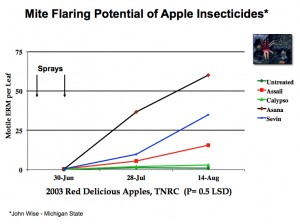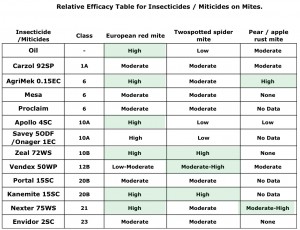Over the past two years, the brown marmorated stink bug has become an economic pest in Hudson Valley apple. A number of farms have employed effective insecticides against this pest, primarily those in the pyrethroid and carbamate groups. These insecticides have reduced the numbers of biological control agents in the orchard to suppress the T. pyri phytophagous mite populations (Typhlodromus pyri (Acari: Phytoseiidae)) giving rise to early season European red mite and two spotted spider mite populations. The use of Carbaryl at thinning will also contribute to the rise of mite during the season, all of which will require mite management as warm dry weather contribute to mite success. 
In years of frequent rainfall and low sunlight from overcast skies, foliage and fruit tend to be very succulent. The lack of leaf cuticle coupled with the tender skin of fruit at petal fall from this weather often makes plant tissue susceptible to spray injury. The use of Captan as a contact fungicide against apple scab (Venturia inaequalis ) is considered to be an essential part of early season scab management in apple production, especially in years of intermittent showers leading to reduced fungicide residual. The use of oil employed in insect and mite pest management, acts as a penetrant to pull Captan molecules into foliage and fruit, where its activity as a biocide causes phytotoxicity to surface plant cells, resulting in economic damage to leaves and fruit. Oil use will also increase the uptake of Carbaryl, increasing the thinning response. With overcast skies leading to a greater carbohydrate deficit, products or combinations with oil may lead to excessive thinning. In years of sustained succulence, the use of oil in the presence of Captan may injure the fruit of certain apple varieties (e.g., russetting on light-skinned varieties such as Golden Delicious).
Yet, for many growers, the backbone of mite management in the Hudson Valley since the late 1990’s has been the use of Agri-Mek®. The active ingredient, avermectin, is a naturally occurring compound, developed through the fermentation process by Streptomyces avermitilis, a soil bacteria in the actinomycete group. Abamectin is a very effective material for use as a miticide against the pome fruit mite complex. It is one of the most effective materials against apple and pear rust mite, providing season long control of this pest in most years.
Agri-Mek® SC (Syngenta) is a new water based formulation of abamectin, employing increased concentration (8.0% Abamectin) for lower use rates between 2.25 and 4.25 fl.oz./A. It replaces the long standing Agri-Mek 0.15 EC formulation (2.0% Abamectin) used at a rate of 10-20 fl.oz./A, both formulations in IRAC’s Group 6 mode of action. Both of these formulations MUST ALWAYS be mixed with a penetrating non-ionic surfactant, in combination with horticultural spray oil used at 0.25% to be effective. And applications of Agri-Mek without a penetrating surfactant such as horticultural spray oil will likely result in significant reduction in the efficacy and/or residual control of the insect and mite population. This would include formulations of abamecin in Agriflexi (Syngenta), a premix formulation with thiomethoxam (Actara) and abamecin (Agri-Mek).

Below are charts of recent studies comparing miticides near petal fall. Hexythiazox (Savey 50DF at 3-6 oz./A, Onager at 12-24 oz./A ) in IRAC 10A and Etoxazol (Zeal at 2.0-3.0 oz./A) in IRAC 10B provided excellent control of the European red mite (ERM) population. These active ingredients act primarily as larvacides (nymphs) and ovicides (egg) of ERM. Through translaminar movement, Zeal enters the leaf and is fed upon by the mite, leading to low viability of the ERM egg (reduced hatch) when fed upon by adults. Hexythiazox is much less effective against the two-spotted spider mite population on apple, whereas Etoxazol provides excellent TSSM control, making it a better late season miticide.



